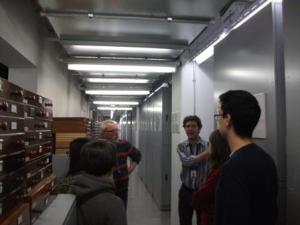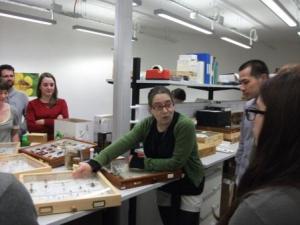On Tuesday (4th February) I had the very pleasant task of escorting the MSc Entomology and Integrated Pest management Students from Harper Adams University on a trip to visit the Entomology Department at the Natural History Museum, London. Despite having to leave at six in the morning all the students were on time (I hesitate to add bright-eyed and bushy-tailed as that would be a patent untruth), but they were there on time. I almost didn’t make it on time, as being a Yorkshire man, I decided that rather than leave my outside light on all day, I would try to make it to my garden gate in the dark. Consequently, I had a very close encounter with my garden pond and turned up at the coach with a wet sleeve, a bruised knee, skinned knuckles and one leg of my jeans tastefully decorated with pond-weed. Still the four-hour journey from Edgmond to London gave me plenty of time to dry out 😉
We arrived as planned at 10 am and were met by Max Barclay , the Collections Manager of Coleoptera and Hymenoptera, otherwise known as @Coleopterist who first told us that there were 22 000 drawers of beetles surrounding us, much more than either the Dipterists or Hymenopterists would be able to show us!
He did confess however, that he was no longer able to claim that beetles were the most speciose group in the world and that the famous quotation might now have to be “ an inordinate fondness for wasps (or possibly flies)”. Nothing daunted he wowed us with the largest beetles in the world, the aptly named Titans, quickly followed by a few of Charles Darwin’s collection from his famous HMS Beagle trip.
Next came some glorious metallic coloured specimens which looked as if they had been painted; interestingly if they had been painted, they would actually be too heavy to fly.
Max kept the students, and me, enthralled for some time and then led us upstairs to the Coleopterist’s Offices. These were fantastic; thanks to an added mezzanine floor, they get to work surrounded by carvings and magnificent windows. What a fantastic place to work.
Some of the researchers such as my friend Chris Lyal @Chrislyal are so dedicated that they rarely leave their chairs resulting in dramatic wear patterns 😉
Next on the agenda was the Hymenopteran collection where we were greeted by Gavin Broad also known as @BroadGavin, the Senior Curator of Hymenoptera. I don’t want you to think that entomologists are competitive and try to out-do each other, but
we were shown the longest wasp in the world; quite impressive, but not a patch on the Titans 😉
This was followed by a fantastic selection of wasp nests (of which I only show a few),
including one wearing a tweed jacket and woolly jumper!
We left the Hymenopteran collection with a reminder of how few taxonomists there are and how much material needs to be sorted and identified; the picture shows just a tiny fraction of the material that comes in each day.
After lunch we joined Erica McAlister @FlygirlNHM, the Collection Manager for Diptera, Fleas and Spiders. She regaled us with stories
of bot flies, maggot-ridden corpses, showed us the maggots from the Ruxton murders (a forensic entomology first)
and demonstrated how some flies twerk! I really should have had a video camera. I must also not forget to mention how many boxes of Dipteran specimens there are still left to identify and catalogue. Again this is only a small selection.
Erica then led us into the bowels of the museum to see some of the largest invertebrates on the planet, giant squids,
albeit not insects but quite impressive. These are not on display to the public because they are preserved in formaldehyde, now deemed to be too dangerous to expose to all and sundry, despite the fact that as a school boy and undergraduate I spent a lot of time dissecting specimens preserved in the stuff, and as I recollect, not wearing gloves or face masks! If you do want to see it, it is possible to take a free tour of the Spirit Collection http://t.co/U49HRoFbhV. It was then time to get back on the coach and head back to Shropshire and Harper Adams University. Here I am, captured on film by one of the students @Ceri_Watkins as I try to make sure that everyone gets back on to the coach!
All in all, a most enjoyable day and many thanks to our hosts for making it so memorable.
Post Script
I think that the thing that impressed us most was the enthusiasm everyone we met had for their particular group. Even we general entomologists tend to have a favourite group of insects, in my case aphids, but the passion that Max, Gavin and Erica have and displayed for their specialities, is something very special indeed. People tend to think of insect taxonomists as weird, introverted, bearded old gentleman. Anyone who has the privilege to meet any of our three hosts will realise how wrong this stereotype is and will wonder why the Government and Research Councils are so reluctant to adequately fund proper taxonomy.
Without a thorough knowledge of the taxonomy and diversity of insects and allied organisms we will continue to be at risk from invasive pests and diseases. If we don’t know what is out there, then how can we be ready to protect our crops and environment from outbreaks, or indeed, know how and what to protect to preserve the wonderful biodiversity which our planet supports. It is time to admit that the funding for the study of vertebrates needs to be scaled back by at least 90% and those resources diverted to the identification and study of the biology and ecology of the dominant animal species of the world, the invertebrates. In case anyone thinks that I am total partisan, I would also call for 20% of the funding devoted to vertebrate research should be dedicated to training plant scientist and funding whole organism botanical research. Please spread the message.





















Does that mean that you want funding for vertebrate research to be cut by 110%? :-}
LikeLike
well it is time they started repaying us for all the resources that have been diverted 😉
LikeLike
I’ll be making the same trip with my final year students later this term. Max is always a great host and it’s a fascinating place to visit.
LikeLike
Reblogged this on The Culture of Enthusiasm and commented:
Another excellent blogpost from @EntoProf! Behind the scenes at the Natural History Museum. Sharon Macdonald’s idea of ‘object-love’ is certainly on display here. I think museum storerooms are fantastic places for teaching and learning. A dedicated space for curiosity!
LikeLike
Excellent stuff. I’m taking my first year human geographers down the hill to Reading’s Museum of English Rural Life in a few weeks. A chance to put my museum geography research into action and my teaching. http://onlinelibrary.wiley.com/doi/10.1111/j.1749-8198.2010.00391.x/abstract
LikeLike
enjoy – sounds like fun
LikeLike
Pingback: A break in the clouds | Miss Apis Mellifera
Pingback: Segments (11) › Expiscor
If you’re repeating the trip this coming term & fancy smuggling in a Silwoodian alumna, I’m probably free that day. 🙂
LikeLiked by 1 person
Pingback: Effervescent entomologists – MSc Entomology London Natural History Museum Visit 2015 | Don't Forget the Roundabouts